Congress Approves, President
Signs Fair Appropriation
-
President
John F. Kennedy, as he conferred with Robert Moses and Thomas
J. Deegan, Jr. some months ago regarding Government participation
in the Fair. The President signed an appropriations bill of $17,000,000
for the Federal Pavilion on July 26.
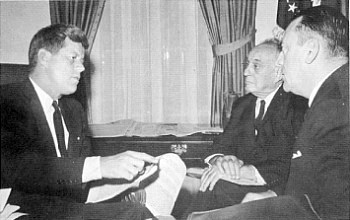 |
|
Congressional approval of an
impressive Federal Pavilion to be erected at the Fair was expressed
emphatically on July 23, when both the Senate and the House voted
an appropriation of $17,000,000 for construction and operation
of the governmental exhibit. The appropriations bill was sent
to President Kennedy immediately and the chief executive signed
it on July 26.
Robert Moses, president of the
Fair, welcomed the news as "an announcement of great significance
not only for the expected 70 million Fair visitors but also,
and more especially, for our nation."
Concepts of the Federal Pavilion
and its proposed theme "Challenge to Greatness" give
promise of an exceptionally fine exhibit that will take maximum
advantage of the Fair's great potential for promoting international
good-will and peace through understanding.
Planned by a citizens' advisory
committee established by Secretary of Commerce, Luther H. Hodges,
the Federal Pavilion will encompass three sections:
1. AN INTRODUCTORY AREA - to
welcome viewers and highlight the purpose of the Pavilion.
2. A SPECIAL EVENTS AREA - to
emphasize the relationship of the individual citizen to local,
state and national governments through examples of historical
events of special significance to the American heritage.
|
Space will also be set aside
in this area to show arts and crafts illustrating native skills
of the American people.
3. A MAIN EXHIBIT AREA - with
displays devoted to progress down to the present and looking
to the future in the fields of public affairs, economics, science,
education, health and the arts.
As described by President Kennedy
in his March 13 message to the House of Representatives the "Challenge
to Greatness" theme of the Federal Pavilion "will enable
us to present to the world not a boastful picture of our unparalleled
progress but a picture of democracy -- its opportunities, its
problems, its inspirations and its freedoms."
The Fair's executive committee
greeted the official green light from Congress as the signal
to give every priority and maximum cooperation to the Commission
responsible for erecting a pavilion of American democracy in
time for Fair Opening Day, April 22, 1964.
In accordance with the legislation
passed, the Fair is now awaiting appointment of a Federal Commissioner
who will be named to plan the exhibit on the 196,349 sq. ft.
site reserved by the United States.
The 68 foreign nations and the
domestic, industrial and commercial community of America who
have already announced participation may now look with confidence
to the host nation as a distinguished fellow exhibitor.
|
|
Source: FAIR NEWS,
Vol. 1, No. 3, August 2, 1962
With General W. E. Potter
looking on, Secretary of Commerce Luther H. Hodges presents Presidential
Certificate to Norman K. Winston (center), naming him to be United
States Commissioner for the New York World's Fair.
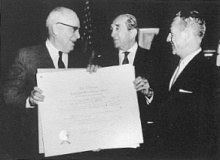 |
|
Mr. Norman K. Winston has been
appointed United States Commissioner for the New York World's
Fair by President Kennedy. Mr. Winston, a builder of international
reputation, has been a trade fair advisor to the U.S. Department
of Commerce for many years
Source: Progress Report
#6, September 12, 1962
|
Norman K. Winston, United
States Commissioner for the New York World's Fair, poses with
the model of the Federal Pavilion.
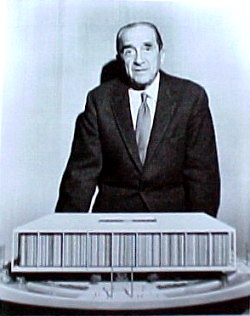 |
|
|
- Weston-Summers, Inc.
- 9229 Sunset Boulevard
- Los Angeles, 69, California
-
- Contact: Charles Luckman,
Jr.
- Contact:
CR 4-9828
|
For: Charles Luckman Associates
For Release Tuesday, 1-22-63 |
FEDERAL PAVILION
- NEW YORK WORLD'S FAIR
"The Federal
Pavilion at the 1964-65 New York World's Fair will be a monumental
structure, more than a city block square, which will seemingly
"Float" 20 feet above the ground on only four supporting
columns," stated Norman K. Winston, U.S. Commissioner to
the Fair, as he announced the project today by unveiling a beautiful
model of the building. This gave the public its first look at
what will be one of the major exhibits of the Fair. President
Kennedy led a host of Federal, State and City officials in the
groundbreaking ceremonies.
Designed by Charles
Luckman Associates, internationally known architectural firm
of Los Angeles, the pavilion will house an exhibition based on
the theme "Challenge to Greatness," which was selected
by the Secretary of Commerce, Luther H. Hodges, upon the advice
of a committee of outstanding citizens appointed by the President.
The entire structure
is elevated in the air, thus permitting the creation, in the
center of the building, of a gracefully rising pyramid of steps
which lead through landscaping and waterfalls, up to the colorful
Garden Court at the second level. A unique feat of engineering
has made possible the supporting of the structure on only four
columns, even though the building itself is 330 feet square.
All four sides of the Pavilion will be cantilevered out 75 feet
from the columns. This is believed to be the largest building
cantilever yet built.
"To bring
such a large building down to the human scale, we have developed
a new type of translucent glass wall," said architect Charles
Luckman. "It will be fabricated of thousands of pieces of
vari-colored glass. In the daytime, the sun will reflect a shimmering
warmth. At night, with reflector lights placed inside the wall,
the sparkle from the muted tones of glass will give a warm and
exciting glow."
|
|
Source: Charles
Luckman Associates January 1963 Press Release
|
The design for
the Pavilion was selected on November 13 by a review committee
representing the U.S. Commissioner, the Department of Commerce
and the General Services Administration. The final design was
chosen from 26 different ideas submitted by the architect. It
was selected as an impressively simple, dignified structure,
providing facilities for the most efficient handling of a traffic
flow of nearly 40,000 visitors per day and meeting the technical
requirements for the exhibits, auditorium, museum and offices.
The Pavilion will
rise 84 feet into the air and has been designed with a center
Garden Court that is 150 feet square. When visitors come to the
end of the Central Mall of the Fair, they will walk under the
cantilevered Pavilion Building. As they near the center, they
will start up the pyramid of steps, or use the glass enclosed
escalators. As they rise, the beauty and human scale of the Garden
Court begins to unfold. Serving as a central meeting place and
access point to all exhibit areas, it is exposed to the sky,
yet protected on all four sides by the inner walls of the Pavilion.
Trees, flowers, fountains, benches, balconies and specially designed
walls of wood will provide an atmosphere of peaceful relief from
the noise and confusion of the Fair.
From the Garden
Court, open bridges are crossed to gain entry into the main exhibit
areas, the museum for historical displays and the auditorium
in which will be held small recitals and international convocations.
The structural
system is composed of four inner trusses measuring 57 feet high
by 172 feet long and four outer trusses which are the same height
but are 330 feet long. These outer trusses are supported by means
of hanger members which transfer the loads to the inner trusses
and then to the four supporting columns. "The result of
this system has two major advantages. This system allows the
use of 75 foot cantilevers, thus creating the "floating"
effect and a reduction in the amount of structural steel required.
The requirements for structural steel have been reduced to 4,340
tons, which is unprecedentedly low for a structure of this size,"
stated Fred Severud, structural engineer on the project. All
of the mechanical and electrical systems are supplied by means
of risers in the columns that support the structure. The mechanical
equipment, such as air conditioning, is housed under the pyramid
of steps.
Del E. Webb is
the prime contractor. Severud, Elstad, Kruger Associates, New
York city, are the structural engineers and Slocum and Fuller,
Inc., New York City are the mechanical and electrical engineers.
# # #
|
|
Model of the Federal
Pavilion for the 1964/1965 New York World's Fair
Source: Progress
Report #7, January 23, 1963
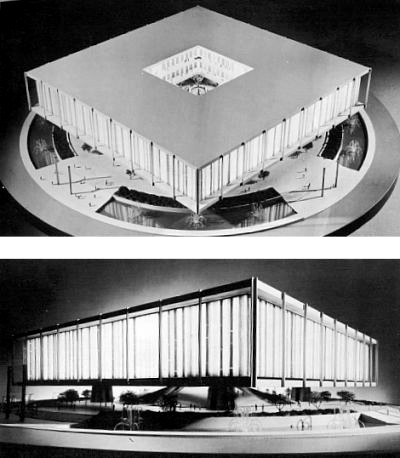 |
NEWS
|
|
FROM: Robert
Jones |
FOR IMMEDIATE RELEASE |
U.S. DISCLOSES EXHIBIT
PLANS FOR
NEW YORK WORLD'S
FAIR PAVILION
NEW YORK CITY,
Dec. 17 -- Exhibitions in the soaring United States Pavilion
now nearing completion at the New York World's Fair will present
"the nation's faith in its land, people, and ideas."
Norman K. Winston,
U.S. Commissioner to the N.Y. World's Fair, made this statement
today as he revealed the government's exhibition plans for the
block-long Pavilion, one of the largest in the Fair.
He said that the
two floors covering 150,000 square feet of floor space will be
used to provide a dramatic visualization of the major challenges
and problems confronting the U.S. today.
New and unusual
techniques have been developed to create a series of informative
displays on the theme, "Challenge to Greatness" which
was chosen last year by a committee of distinguished U.S. citizens,
Commissioner Winston said.
The 330-foot long
Pavilion, elevated 20 feet above the ground, will accommodate
40,000 visitors daily. It is the largest fair exhibition yet
undertaken by the government. The United States Commission was
formed in 1962 by the U.S. Department of Commerce.
Among the highlights
are:
A 9-minute film
about the origins of U.S. citizens;
- MORE -
|
|
| UNITEDx.STATESX.COMMISSION
|
| NEW YORK WORLD'S FAIR
1964-5
|
| DEPARTMENT-XOF-XCOMMERCE
|
| 60 WEST 49 ST..NYC20..LT1-6611 |
|
|
|
U.S. COMMISSION
TO THE N.Y. WORLD'S FAIR - Add 1
- News machines, a space satellite,
and other dramatic elements to portray the nation's most important
challenges;
- 15-minute ride through 130
enveloping motion picture screens; and
- Computer-oriented library
providing facts and information about the exhibit.
Commissioner Winston, appointed
by President John F. Kennedy to develop and administer the U.S.
participation in the World's Fair, is an inveterate fair-goer.
He served in official capacities in the 1959 Moscow Fair and
trade fairs in Poznan, Zagreb, Vienna, and Paris.
Commissioner Winston explained
the exhibition will concentrate on portraying the national spirit
and character.
Quoting from the report of
the citizens' advisory committee that selected the exhibit's
theme, Commissioner Winston said the displays will invite interest:
"...Not in our achievements but in the spirit which leads
to them ... (in) helping visitors to see and understand our challenges,
our responsibilities, our dedication, and provide a more accurate
and meaningful excursion into the character of a nation that
serves as a model for freedom and bears the burden of proof that
a democratic system succeeds."
Visitors, entering the raised
Pavilion from its enclosed garden court, will read these lines
from a poem by Archibald MacLeish:
- "The American Journey
has not yet ended.
- America is never accomplished.
- America is always to build."
From the entrance foyer, visitors
will proceed to a hall and view a 9-minute film titled, "The
Voyage to America." The film tells the story of the nation's
immigrant origins, and portrays dramatically why succeeding waves
of immigrants were drawn to our shores.
- MORE -
|
|
|
U.S. COMMISSION
TO THE N.Y. WORLD'S FAIR - Add 2
Next, in two large halls,
visitors will see exhibits depicting some of the major challenges
before the U.S. today, as interpreted by the designers.
Some of these challenges --
including Democracy, growth, learning, the arts, special concerns
such as automation and urban renewal, the sciences, and equal
rights -- embrace domestic problems within our own boarders.
Others pertain to international
relations, including the Free World, developing nations, UN,
arms control, population explosion, the world community, and
space.
Commissioner Winston said
each of these challenges is explained in a dramatic, often unique,
three-dimensional manner. For example, a weather satellite station
monitors signals from Tiros in orbit.
There are also teaching machines,
news machines, a coal-digging machine located in this section
to help dramatize the nation's challenges, Commissioner noted.
After touring the "challenges"
section, Commissioner Winston said visitors will move to the
Pavilion's upper floor for a 15-minute ride. Here visitors will
travel on 12 moving grandstands on an excursion through the great
sights and sounds of American history. During the "ride"
the visitor will be enveloped by filmed images and become the
object of stereophonic effects -- all deigned to make him "an
actual participant in the nation's history-making events,"
Commissioner Winston said.
"We believe the ride
will be an inspirational experience for each visitor," the
Commissioner said. "It will bring into sharp focus what
it means to be a U.S. citizen; the great advantages and, of course,
the great responsibilities."
- MORE -
|
|
|
U.S. COMMISSION
TO THE N.Y. WORLD'S FAIR - Add 3
Visitors may also visit the
pavilion's 10,000-square-foot library where literature and other
printed materials will be available. The library, sponsored by
the American Library Association, will be staffed with experienced
librarians, aided by an electronic computer for retrieving facts
and data on every subject covered in the entire "Challenge
to Greatness" exhibition.
Commissioner Winston said
work on the Pavilion is on schedule. "It will be ready to
receive the first visitors on April 22 when the fair opens."
- 30 -
|
|
Source: US World's
Fair Commission December 1963 Press Release
NEWS
|
|
FROM: Robert
Jones |
FOR RELEASE: Dec. 17,
1963 |
AMERICAN HISTORY
TO BE DEPICTED
IN UNIQUE FILMED
EXPERIENCE
AT U.S. WORLD'S
FAIR PAVILION
A 15-minute "you-are-there"
journey through America's rich 480-year history awaits visitors
to the big United States Pavilion at the New York World's Fair.
Using new techniques
that "surround" viewers with sound and film, audiences
will travel through time, from the discovery of North America
to a Space Age moon landing.
The "American
Journey" will occupy the entire 75,000-square-foot upper
level of the U.S. Pavilion, according to Norman K. Winston, U.S.
Commissioner to the N.Y. World's Fair.
Groups of 55 persons
will be transported on this "adventure in history"
in specially-designed, open-top conveyances.
The 15-minute journey,
Commissioner Winston explains, will be presented through films
projected on more than 130 differently-shaped screens. Stereophonic
speakers in the headrests of each contour seat will bring narrative,
music, and sound effects to comfortably-seated "travelers."
- MORE -
|
|
| UNITEDx.STATESX.COMMISSION
|
| NEW YORK WORLD'S FAIR
1964-5
|
| DEPARTMENT-XOF-XCOMMERCE
|
| 60 WEST 49 ST..NYC20..LT1-6611 |
|
|
|
U.S. COMMISSION
TO THE N.Y. WORLD'S FAIR - Add 1
"This film journey will
surround viewers with a sound-and-picture adventure that will
leave them enlightened, entertained, and impressed with this
nation's historical background and future challenge," Commissioner
Winston said.
The presentation, under the
direction of Commissioner Winston, is being produced by Cinerama,
Inc., at the film-maker's Redwood, Calif. studios.
Camera crews have ranged the
U.S. for unusual and historic sequences to be incorporated into
the final footage. Museums and government agencies also have
contributed suggestions and ideas to authenticate the story-line.
"'American Journey' is
intended to be a total experience, and a startling adventure
at every turn," Commissioner Winston said. "We fully
expect that audiences will take this journey four or five times
and enjoy a new experience each time."
- 30 -
|
|
Source: US World's
Fair Commission December 1963 Press Release
NEWS
|
|
FROM: Robert
Jones |
FOR RELEASE: Dec. 17,
1963 |
AMERICA'S LIVELY
ARTS TO BE FEATURED
AT U.S. PAVILION
AT WORLD'S FAIR
Top-level entertainment
drawn from the best of America's lively arts will be an integral
part of the United States Pavilion at the New York World's Fair.
A 600-seat theater,
a 200-seat auditorium, and a 3 1/2 acre mall -- a part of the
U.S. exhibit -- will be the settings for special events that
include films, dramas, musical comedies, recitals, seminars,
and readings.
Norman K. Winston,
U.S. Commissioner to the New York World's Fair, said that visitors
to the Pavilion's 600-seat theater will view a film which highlights
"the heritage and legacy of the American spirit and the
rich cultural contributions to our society of the nation's 40
million immigrants."
Commissioner Winston
said the film will serve as the introduction to the U.S. Pavilion's
exhibits. The film is being produced under the direction of John
Houseman, head of the U.C.L.A. Drama Work Shop and former director
of the Shakespeare Theater at Stratford-on-Avon. He is also a
recipient of several awards for prize-winning television dramas.
- MORE -
|
|
| UNITEDx.STATESX.COMMISSION
|
| NEW YORK WORLD'S FAIR
1964-5
|
| DEPARTMENT-XOF-XCOMMERCE
|
| 60 WEST 49 ST..NYC20..LT1-6611 |
|
|
|
U.S. COMMISSION
TO THE N.Y. WORLD'S FAIR - Add 1
Arrangements are being made
with Virgil Thompson, well known American composer and conductor,
to compose original music for the film. Mr. Thompson who is a
former New York City newspaper music critic has created musical
scores for the films "Louisiana Story" and "The
River."
The 200-seat theater will
be used for selected performances of American dramas, musicals,
and various types of recitals.
On the Mall a special events
program will be initiated "to present the quality, creativity
and vitality of grass-roots America," according to Commissioner
Winston. Included will be forums utilizing outstanding talent,
amateur and professional folk musicians, concert artists, choral
groups, ballet, jazz combinations, symphony orchestras, and string
quartets.
"Our goal is to present
at the U. S. Pavilion some of the nation's outstanding talent
in programs that will express the American spirit, which, of
course, is the underlying theme of the Pavilion," Commissioner
Winston declared.
- 30 -
|
|
Source: US World's
Fair Commission December 1963 Press Release
Artist's depiction of
the "American Journey" Ride at the Federal Pavilion
where visitors, seated in open-top conveyances, ride past film
depictions of American History.
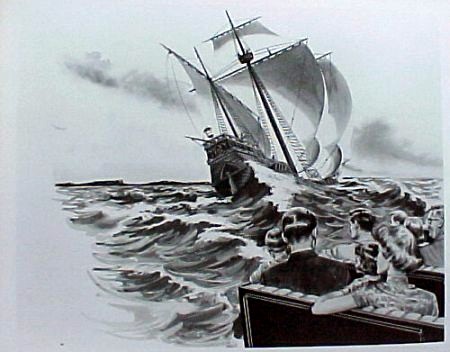 |
NEWS
FACT SHEET
United States
Commission to the 1964-5 New York World's Fair
| Background |
Federal participation was
authorized by the late President Kennedy under the terms of the
Mutual Educational and Cultural Exchange Act of 1961, and Congress
appropriated $17 million for the purpose in July, 1962.
The U.S. Commission to the
1964-5 New York World's Fair was formed in August 1962 within
the U.S. Department of Commerce.
Norman K. Winston was appointed
by President Kennedy to head the Commission with the official
title of U.S. Commissioner to the 1964-5 New York World's Fair.
|
| Theme of the U.S. Pavilion |
"Challenge to Greatness"
was recommended by a citizens' advisory committee appointed by
U.S. Secretary of Commerce Luther H. Hodges and under the chairmanship
of Charles F. Spalding. The committee recommended that the United
States exhibit invite interest "not in our achievements
but in the spirit which leads to them ... Helping visitors to
see and understand our challenges, our responsibilities, our
dedication, would provide a more accurate and meaningful excursion
into the character of a nation that serves as a model for freedom
and bears the burden of proof that a democratic system succeeds." |
| U.S. Pavilion |
Twenty-eight preliminary designs
were submitted by the architectural and engineering firm, Charles
Luckman Associates of New York and Los Angeles. From these, four
were chosen for development on esthetic and practical grounds.
A final choice was made November 13 by a review committee, representing
the U.S. Commission, Department of Commerce and General Services
Administration. |
|
| UNITEDx.STATESX.COMMISSION
|
| NEW YORK WORLD'S FAIR
1964-5
|
| DEPARTMENT-XOF-XCOMMERCE
|
| 60 WEST 49 ST..NYC20..LT1-6611 |
|
|
-2-
| Location: |
At one end of a central mall
facing the Unisphere, theme of the Fair. |
| Site: |
4 1/2 acres. |
| Building: |
150,000 square feet completely
raised on four columns; 330 feet in length; 84 feet high. |
| Capacity: |
40,000 visitors daily - limited
by exhibit traffic flow. |
| Structural Engineers: |
Severud, Elstad, Krueger Associates,
New York. |
| Mechanical and Elec. Engineers: |
Slocum & Fuller, Inc., New
York. |
| General Contractor: |
Del E. Webb Corp., Phoenix. |
| Construction Supervision: |
General Services Administration. |
| Construction Start: |
December 14, 1962. |
| Exhibition Walk Through |
Visitors will enter the elevated
building from under the cantilevered structure, climbing a pyramid
of steps or riding escalators to a second-level Garden Court
which will serve as a central meeting place with access point
to the building.
The lower level exhibition
hall will be devoted to presenting the following subject material:
Challenge to Greatness: The
American Journey -- tells the story of immigration and our present
unique diversity.
The Challenges: Today -- presents
our opportunities and goals, and also deals with the real concerns
-- our social and moral ideas.
The second level of the building
is devoted to defining the commitments and responsibilities of
the individual in our nation -- a society dedicated to the welfare
of all. Here the visitor will embark upon a "ride"
through a theatrical experience.
Here is summarized the essential
spirit of the exhibition and the nation. It will project indelibly
the possibilities of a truly free life in a democracy dedicated
to the welfare of all men everywhere.
|
|
-3-
| Special Events |
On the open mall surrounding
the Pavilion, regular programs of American music and lively arts
will be offered. |
| The Information Area |
Before leaving the Pavilion,
visitors will be able to acquire further information about subjects
that have been treated within the exhibit. A computer facility
is planned where visitors will be able to indicate certain facts
relating to material in the exhibit. |
| U.S. Commission Personnel |
- Norman K. Winston, Commissioner
- Nathan Ostroff, Deputy Commissioner
- Philip B. George, Assistant
Commissioner for Design and Exhibits
- Samuel Kingsley, Assistant
Commissioner for Administration
-
- Address:
|
United States Commission to
the 1964-5 New York World's Fair
- 609 West 49th Street
- New York 20, New York (LT
1-6610)
-
- Room 5896
- U.S. Department of Commerce
- Washington 25, D.C.
|
|
Source: US World's
Fair Commission Fact Sheet |
Model of the Federal
Pavilion for the 1964/1965 New York World's Fair
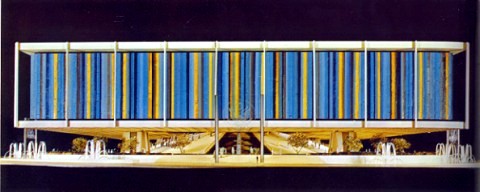 |
|